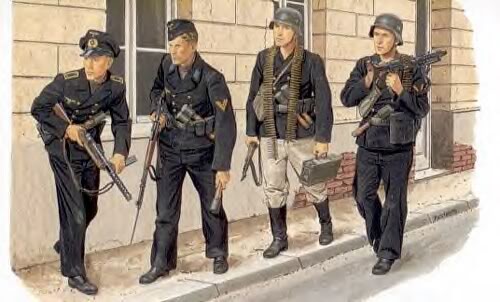
The 1st Naval Infantry Division on the Eastern Front. Generalmajor Wilhelm Bleckwenn succeeded Konteradmiral Hans Hartmann as commander of the 1st Naval Infantry Division under Army Group Weichsel (Vistula) on the Eastern Front. Formed on 31 January 1945, the division was composed of excess naval personnel who no longer had ships or submarines to man. Committed to combat against the Russians on the Oder River south of Stettin, the 1st Naval Infantry Division suffered heavy losses in fierce defensive fighting in the bridgehead between Alt Damm and Greifenhagen. After being forced back to the west bank of the river, the division continued to see heavy defensive combat against the advancing Russians. Withdrawing across Mecklenburg to Neustrelitz, the remnants of the 1st Naval Division then crossed the demarcation line between the Soviet and Anglo-American forces and surrendered to the British along with the rest of General der Panzertruppe Hasso von Manteuffel’s 3rd Panzer Army. The coastal artillery personnel and Naval Division personnel received a uniform in cloth – feldgrau – of very similar pattern to the army.
Coastal Artillery NCO.
The naval divisions formed in 1945 were a new generation of this type of formation; though sometimes called “marines” by English-language writers they were in no way equivalent to the old Sea Battalions or the United States Marine Corps. These were instead hastily raised divisions, maintained under naval authority to help boost the Kriegsmarine’s political standing among the assorted Nazi hierarchies — just as police and even firemen went to the front in their own formations, led by their own officers.
Germany lost her colonies in the Versailles peace accords, and together with the colonies went the rationale for the Sea Battalions. The post-war Reichsmarine maintained base security detachments, and by the late 1930s the Kriegsmarine had added “Marine Assault Companies” — actual marines in the American sense of the word. These troops took part in the first action of World War II in Europe, attacking the Polish naval base at Westerplatte in Danzig’s harbor under covering fire from the ancient battleship Schleswig-Holstein. The Poles resisted stoutly, and the marines did not emerge from their first action with a very high military reputation.
Kriegsmarine ground units continued to see action over the next several years, but always as the result of emergencies where security detachments or base personnel were drawn into the fighting — for example, in the defense of Novorossisk in 1942, at Messina in 1943 or at Sevastopol in 1944. Otherwise, they were not seen as true ground combat elements. Coast defense artillery had been part of the Reichsmarine, and expanded greatly to protect the shores of occupied Europe from Allied invasion. But these gunners, who included a large contingent of anti-aircraft troops, were definitely not considered combat forces.
In April 1940, crews from destroyers sunk in the Narvik operation formed three small ad hoc battalions that took part in defense of the Norwegian port alongside German mountain troops. They were led by their own officers and armed with weapons taken from the Norwegian 6th Division’s arsenal, which had been overrun by the mountaineers. But as soon as the operation was concluded, these units were dissolved and the men became sailors again.
As German forces fell back from France, the Soviet Union and the Balkans, naval personnel became involved in ground fighting at numerous locations. By November 1944, the Navy had taken its cue from the Air Force and began to form an infantry brigade for coast defense on the North Sea. By February it was on its way to Stettin for front-line service as the 1st Naval Infantry Division. The unit received a cadre of officers from the Army, including a new commander, Maj. Gen. Wilhelm Bleckwenn, and was organized along the Army’s 1945 tables. It fought, usually poorly, for the remainder of the war on the northern flank of the German line on the Oder River.
The 2nd Naval Infantry Division formed in Schleswig-Holstein in March 1945 and went to the front in April (again, with the infusion of an Army cadre including a new commander) and fought the British and Canadians around Bremen. Three more “divisions” (the 3rd, 11th and 16th) were ordered form, but none seem to have seen much action, if any.
3rd Panzer Army (Gen Hasso von Manteuffel)
‘Swinemunde’ Corps (Lt Gen Ansat)
402nd & 2nd Naval Divisions
XXXII Corps (Lt Gen Schack)
‘Voigt’ & 281st Infantry Divisions
549th Volksgrenadier Division
Stettin Garrison
‘Oder’ Corps (SS Lt Gen von dem Bach / Gen Hörnlein)
610th & ‘Klossek’ Infantry Divisions
XXXXVI Panzer Corps (Gen Martin Gareis)
547th Volksgrenadier Division
1st Naval Division
Additionally, large numbers of Kriegsmarine personnel were transferred directly to units at the front during April. The 20th Panzer Grenadier Division fighting in front of Berlin received several thousand Kriegsmarine replacements and sent them into action still wearing their naval uniforms.
Sailors also were sent to the 32nd SS Grenadier Division, also in their old uniforms (a blessing in this case, as the Soviets rarely took prisoners clad in SS camouflage). Small naval units also showed up as ad hoc reinforcements alongside the Volkssturm and police units rushed to the front, including several hundred trainees from the Kriegsmarine’s radar school — that the Navy was still training radar operators with the Soviets smashing their way into the capital goes far to illustrate the Nazi state’s “efficiency.”
The naval troops in Road to Berlin are of poor quality, with much lower firepower than regular Army units and lower morale. They appear to have been armed with captured weaponry for the most part, and suffered from serious ammunition shortages as a result. The ratio of Navy to Army officers in the front lines is hard to determine, and in the game they draw their leaders from the general Army pool.